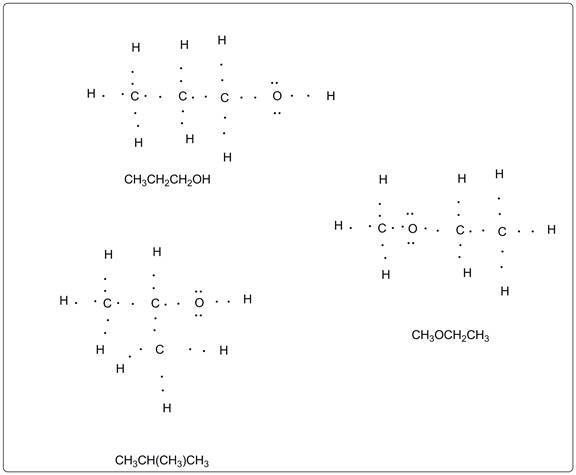
Concept explainers
Interpretation:
Octet rule must be used to draw Lewis structures of all the possible compound with the formula C3H8O.
Concept introduction:
Lewis dot structure is the representation of a molecule with the valence electrons shown as dots.
C3H8O is a general molecular formula which represents structures for alcohols and ether.
Explanation of Solution
Two alcohols are possible with the general formula C3H8O. One is Propan-1-ol and another is propan-2-ol. In all the structures octet rule is followed as per which there are eight electrons in all the participating atoms including bond pairs and lone pairs of electrons except hydrogen.
One ether is possible with this formula which is methoxyethane with the formula CH3OCH2CH3.
All the Lewis dot structures possible for C3H8O are given below.

Chapter U2 Solutions
Living By Chemistry: First Edition Textbook
Additional Science Textbook Solutions
Microbiology with Diseases by Body System (5th Edition)
Genetic Analysis: An Integrated Approach (3rd Edition)
Human Anatomy & Physiology (2nd Edition)
Physics for Scientists and Engineers: A Strategic Approach, Vol. 1 (Chs 1-21) (4th Edition)
Chemistry: An Introduction to General, Organic, and Biological Chemistry (13th Edition)
Human Biology: Concepts and Current Issues (8th Edition)
- A. What is the correct structure for a-D-glucopyranose? CH₂OH a HO HO- OH b HO HO- OH HOH₂C OH OH OH CH₂OH HO C. HO HO- OH OH CH₂OH OH OH B. Draw structures for the products you would expect to obtain from reaction of B-D-galactopyranose with each of the following reagents. Be sure to include all relevant stereochemistry. [FOUR only] A. CH, Ag₂O B. warm dilute HNO3 C. (CH3CO)20, pryridine D. NaBH in H₂O E. CH₂OH, HCI F. Br₂, H₂O HO CH₂OH HO- OH OH B-D-galactopyranosearrow_forwardGive the major organic product(s) for each of the following reactions or reaction sequences. CH₂CN 5% NaOEt, EIOH سجد سی . بلی H 1. NaOCH, CH,OH CH3 OCH3 2 H₂O*arrow_forwardDraw the structures for each of the intermediates in the boxes provided for the synthesis below. 004 HNO F HO CHCO) D Dydre R.SO. 1.1 NO fe HO H.SO. 2. CC1 NOH HO MCL HNO, H.50.arrow_forward
- . Each of the following compounds can be prepared by a mixed aldol condensation reaction. Give the Cructures of the aldehyde and/or ketone precursors for each aldol product and formulate the reaction. 0 CH=CHCCH 3. Ph 1arrow_forward. Consider the reaction below to answer the following question: H NaOEt H BOH بلی H + H₂O A. Write the complete stepwise mechanism for the reaction above. Show all intermediate structures and all electron flow with arrows. B. This reaction is an example of: an intramolecular aldol condensation a. an intramolecular Claisen condensation b. C. d. a Robinson annulation a Michael reaction C. The product of this reaction is: a. b. C. d. a ẞ. y-unsaturated aldehyde an a, B-unsaturated ketone an a, B-unsaturated aldehyde an enolarrow_forwardClassify each of the following nitrogen atoms in the following compounds as primary, secondary, tiary, or quaternary. A. B. C. CH3 HO-CHCHNHCH3 ephedrine CH CHCH3 amphetamine NH₂ D. CF H3C CH3 mapiquat chloride HO fexofenadine OH H3C CH3 CO₂Harrow_forward
- .. Name each of the following compounds by IUPAC rules. [three Only] A. 0 B. C. Cl NH₂ OCH N CH3 NHCH2CH3 D. CH O₁₂N NH₂arrow_forwardDraw the structure of the aldol self condensation product for each of the following compounds if a compound does not under go aldol self condensation explain whyarrow_forwardIndicate how the addition of a nucleophile :NuH2 to a ketone R-CO-R occurs.arrow_forward
- Indicate the compound that gives us a primary carbocation and that gives us a secondary carbocation: R-CHO and R-CO-Rarrow_forwardDraw a stepwise mechanism for the following reaction. OHarrow_forwardHelp with annotating the labeled peaks in the 'H NMR (solvent CDCls) spectra and 'H NMR (solvent Acetone-D6) spectra Also help with Calculating the keto-enol tautomerization Ka constant for the product in both solvents.Two solvents and two different Kaarrow_forward
 ChemistryChemistryISBN:9781305957404Author:Steven S. Zumdahl, Susan A. Zumdahl, Donald J. DeCostePublisher:Cengage Learning
ChemistryChemistryISBN:9781305957404Author:Steven S. Zumdahl, Susan A. Zumdahl, Donald J. DeCostePublisher:Cengage Learning ChemistryChemistryISBN:9781259911156Author:Raymond Chang Dr., Jason Overby ProfessorPublisher:McGraw-Hill Education
ChemistryChemistryISBN:9781259911156Author:Raymond Chang Dr., Jason Overby ProfessorPublisher:McGraw-Hill Education Principles of Instrumental AnalysisChemistryISBN:9781305577213Author:Douglas A. Skoog, F. James Holler, Stanley R. CrouchPublisher:Cengage Learning
Principles of Instrumental AnalysisChemistryISBN:9781305577213Author:Douglas A. Skoog, F. James Holler, Stanley R. CrouchPublisher:Cengage Learning Organic ChemistryChemistryISBN:9780078021558Author:Janice Gorzynski Smith Dr.Publisher:McGraw-Hill Education
Organic ChemistryChemistryISBN:9780078021558Author:Janice Gorzynski Smith Dr.Publisher:McGraw-Hill Education Chemistry: Principles and ReactionsChemistryISBN:9781305079373Author:William L. Masterton, Cecile N. HurleyPublisher:Cengage Learning
Chemistry: Principles and ReactionsChemistryISBN:9781305079373Author:William L. Masterton, Cecile N. HurleyPublisher:Cengage Learning Elementary Principles of Chemical Processes, Bind...ChemistryISBN:9781118431221Author:Richard M. Felder, Ronald W. Rousseau, Lisa G. BullardPublisher:WILEY
Elementary Principles of Chemical Processes, Bind...ChemistryISBN:9781118431221Author:Richard M. Felder, Ronald W. Rousseau, Lisa G. BullardPublisher:WILEY





